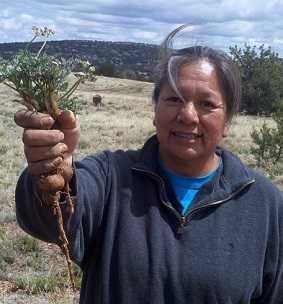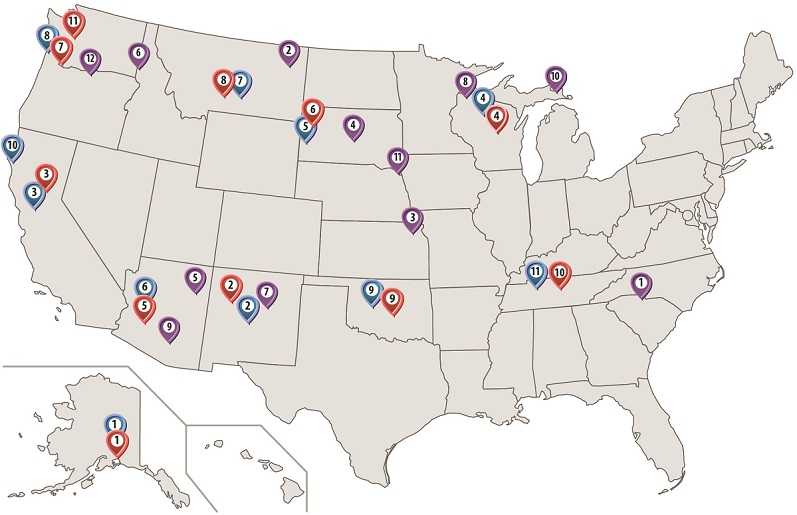Good Health and Wellness in Indian Country
CDC’s largest investment to improve health among American Indians and Alaska Natives is the Good Health and Wellness in Indian Country (GHWIC) program, a $78 million initiative that started in 2014 and continues through 2019, and supports tribes, tribal organizations, and tribal epidemiology centers (TECs).
- Twelve tribes work on effective community-chosen and culturally adapted strategies to reduce commercial tobacco use and exposure, improve nutrition and physical activity, increase health literacy, and strengthen team-based health care and community-clinical links.
- Eleven tribal organizations, one in each of the 10 Indian Health Service (IHS) administrative areas and the Urban Indian Health Institute, work to provide leadership, assistance, and resources to over 100 tribes and tribal organizations in their IHS area, as well as to GHWIC funded tribes.
- Twelve TECs support surveillance and evaluation activities.
GHWIC addresses the following long-term goals:
- Reduce rates of death and disability from tobacco use by 5%.
- Reduce the prevalence of obesity by 3%.
- Reduce rates of death and disability from diabetes, heart disease, and stroke by 3%.

Twila Cassadore, from the Traditional Western Apache Diet Project, holding San Bitsitsin, an Apache wild parsnip.
Evaluation
Eleven TECs provide technical assistance to tribes and tribal organizations in their area to evaluate the impact of program activity at the tribe and area levels. The Urban Indian Health Institute coordinates the national evaluation of GHWIC. TECs perform a variety of functions in consultation with, and at the request of, tribes and tribal organizations to monitor the health of American Indians and Alaska Natives and support evaluation activities. The Urban Indian Health Institute coordinates a national evaluation of the program, while the area TECS support individual program and area-wide evaluation.
Activities
The following are some of the GHWIC grantee Year 1 activities:
- The Yellowhawk Health Center of the Confederated Tribes of the Umatilla Indian Reservation in Pendleton, Oregon, is implementing a walking program, Walk the Rez, modeled after national walking programs and Let’s Move in Indian Country. The health center has integrated cultural information and place-based content into walking journeys that cross tribal land. People who walk or run on the trails learn about local landmarks, history, and lifeways of the Umatilla, Walla Walla, and Cayuse people, while enjoying physical activity.
- Albuquerque Area Southwest Tribal Epidemiology Center (AASTEC) AASTEC partners with the University of New Mexico’s Project ECHO to train tribal health care paraprofessionals in the 27 Albuquerque Area tribes to help tribal members prevent and manage type 2 diabetes, cardiovascular disease, stroke, and associated risk factors. The training is offered to as many as 25 tribal paraprofessionals twice a year during each of the 5 project years; it trains and mobilizes up to 200 tribal professionals. These trained community health representatives (CHRs) will work with community members with or at risk for chronic diseases to reduce their risks and improve their health. Tribal members who work with the CHRs will be followed over time to understand the extent to which the training improved the CHRs’ ability to motivate clients to make behavior changes.
- The Winnebago Tribe of Nebraska implemented Wa i pi Nagu—“Path to Good Blood”—a program adapted from the IHS curriculum, Balancing Your Life and Diabetes. Winnebago’s Wa i pi Nagu is accredited by the Association of American Diabetes Educators and provides diabetes self-management education to help people manage their diabetes and avoid diabetes complications.
- The California Rural Indian Health Board worked with 43 tribes to complete community health assessments using a culturally adapted Community Health Assessment and Group Evaluation tool. These health assessments will help tribes prioritize their health needs and plan action steps to address the top chronic disease issues identified by each community.
Resources
Good Health and Wellness in Indian Country: FY 2016 Investments (34 Awards)
National Center for Chronic Disease Prevention and Health Promotion


Tribes (Component 1)
- Catawba Indian Nation
- Fort Peck Community College
- Kickapoo Tribe in Kansas
- Lower Brule Sioux Tribe
- Navajo Nation
- Nez Perce Tribe
- Pueblo of Santa Ana
- Red Cliff Band of Lake Superior Chippewa
- San Carlos Apache Tribe
- Sault Ste. Marie Tribe of Chippewa Indians
- Winnebago Tribe of Nebraska
- YellowHawk Tribal Health Center

Tribal Organizations (Component 2)
- Alaska Native Tribal Health Consortium
- Albuquerque Area Indian Health Board, Inc.
- California Rural Indian Health Board, Inc.
- Great Lakes Inter-Tribal Council, Inc.
- Great Plains Tribal Chairmen’s Health Board
- Inter-Tribal Council of Arizona, Inc.
- Montana and Wyoming Tribal Leaders Council
- Northwest Portland Area Indian Health Board
- Southern Plains Tribal Health Board
- United Indian Health Services, Inc.
- United South and Eastern Tribes, Inc.

Tribal Epidemiology Centers (TEC)
- Alaska Native Epidemiology Center
- Albuquerque Area Southwest TEC
- California TEC
- Great Lakes Inter-Tribal Epi Center
- Inter-Tribal Council of Arizona TEC
- Northern Plaines TEC
- Northwest TEC
- Rocky Mountain TEC
- Southern Plains TEC
- United South and Eastern TEC
- Urban Indian Health Institute
- Page last reviewed: May 31, 2017
- Page last updated: May 31, 2017
- Content source:



 ShareCompartir
ShareCompartir